
Photographica Pages
An online guide to collectable cameras and related stuff
Nikon F (with non-meterd prism finder)
In late 1959, Nippon Kogaku introduced a camera that changed the photographic world, as well as the
company that developed it. That camera is the Nikon F.
The concept of an SLR camera was not new. The design was made popular by Folmer And Schwing
(the Graflex) and numerous others in large format around the turn of the century. Nor was the concept
of a 35mm SLR new. In 1936 the German firm Ihagee introduced the Kine-Exakta, which may or may
not be the first 35mm SLR, as the Russian Sport (spelled Cnopm in Cryllic) may have taken that honor
in 1935. The Exakta was popular, mainly as a tool for scientests, or for photographers wishing to use
long lenses or do close-up work. In 1959 the photograhic world revolved around the rangefinder
camera. How did Nippon Kogaku pull this off?
Part of the success has to be attributed to timing. The world was moving that direction whether it knew
it or not. Asahi introduced it's Asahiflex early in the 1950's, and had an SLR similar in layout to the
Nikon F in 1957. But they were a relatively unknown company. Canon introduced the Canonflex in
1959. But it was hampered by its trigger wind on the baseplate, lack of a comprehensive system, and
mostly reluctance on Canon's part to move away from the rangefinder design that was selling so well for
them. They didn't get serious about marketing an SLR until 1971, with the introduction of the F-1.
Topcon jumped into the market in 1959, but they built TLR cameras, as well as rangefinders. Zeiss had
the Contaflex series of SLRs from as early as 1953. But these were not professional grade machines.
And their professional line, the Contarex, introduced in 1959, was more expensive, heavier and lacked
many of the features of the Nikon.
So what did the Nikon F have going for it? Well to start with, the reigning professional SLR of choice,
the Exakta, was a cumbersome aging design. It had left-handed controls, and the basic design had not
been much improved upon since 1936. The Exakta lacked the instant return mirror of the Nikon, it's
speed dials were split between fast and slow speeds, where the Nikon had a single, non-rotating shutter
speed dial. The Nikon was brighter to view through, and it's controls were laid out better. They fell in
the same time proven location as most of the 35mm rangefinder cameras of the day (with the notable
exception of the focusing wheel on the Nikon RF and the Contax). In addition, the camera had a fully
automatic diaphragm, depth of field preview and mirror lock-up.
The Nikon F is a robust machine. It was derived as a logical extension of the Nikon rangefinder system.
It was developed concurrently with the SP, and in fact was supposed to share the same frame. While
this turned out to be impractical, the mirror cage is too large to fit into the chassis of the SP, many of
the parts are of similar design, if not shared. After more than 25 years, most of the Nikon F cameras
(and SPs as well) are still working well, even after long, hard professional use. And when they did
require service, their intelligent design allowed for ease in repair.
On top of all of that, it was initially offered with a decent size system. It included four lenses, 35/2.8,
50/2, 105/2.5 and 135/3.5, an interchangeable finder that could be replaced with a waist level finder,
three different focusing screens, a clip on meter that coupled to the shutter speed dial and the lens
aperture, and of course, the motor drive. In addition, with the N-F tube you could use the long lenses
from the Nikon rangefinder system, the 180/2.5, 250/4, 350/4.5 and the 500/5. It may not sound like
much today, or in comparison to the more mature rangefinder systems of the day, but for an SLR it was
a winning combination. And Nippon Kogaku wasn't finished. The system grew, and by the end of 1960
the 21/4, 28/3.5, 58/1.4 and 1000/6.3 were available. In 1961 they introduced the Micro-Nikkor. In
1962 they introduced the first metered finders sand the 8/8, the worlds first fisheye for a 35mm camera.
They never let up. The Nikon system became the most extensive and complete system available, and
arguably the most usable of it's time.
There was one other reason that the Nikon F sold as well as it did. That reason was Joe Ehrenreich,
head of Ehrenreich Photo Optical Industries, or EPOI. EPOI was the company responsible for the
marketing and distribution of Nippon Kogaku's photo products in the US. Ehrenreich was responsible in
part to the emergence of Nikon as a respected name in professional circles. He targeted the
professional market, working with photojournalists to find out what they liked, and didn't like, about the
current cameras. New items were often loaned, or even given to working pros. It was Ehrenreich who
opened the door for Nikon to prove itself.
When Ehrenreich handled the Nikon F, he knew this was the future. He concentrated his energies
towards promoting the new camera, and used his influence with Nippon Kogaku to direct resources in
development and production towards the F. He got it in the hands of working pros, and they loved it.
Soon the Nikon F was synonymous with professional photography. To the lay person, professional
photographers used Nikons. And so many serious, and even not-so-serious amateur photographers
bought Nikons, as they were professional cameras.
The Nikon F led the change from 35mm rangefinder to SLR. It also sped the demise of the twin lens
reflex. It made Nikon the leader in the professional market by such a margin that it was difficult to find
who was second. And the Nikon F helped the Japanese camera industry as a whole, giving it the
respect it deserved, allowing it to bury the German industry. By the time the F was discontinued in
1974, Leica had become reduced to a market niche, Rollei was fast on it's way to bankruptcy, and
Zeiss Ikon had discontinued camera production.
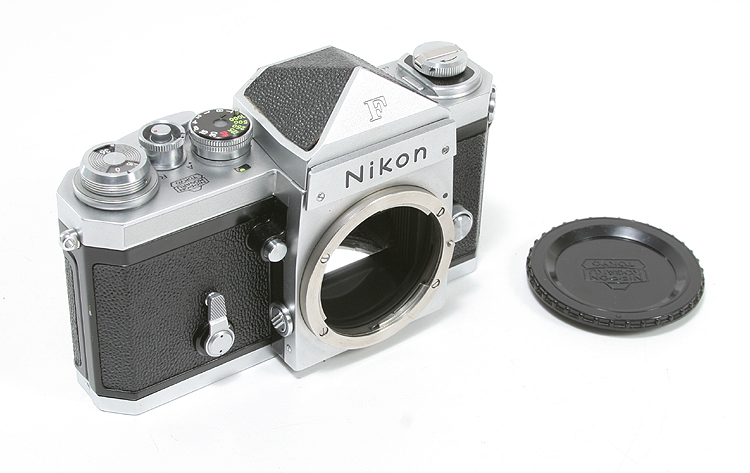
A fairly early chrome Nikon F body with non-metred prism finder and a NKK logo body cap.
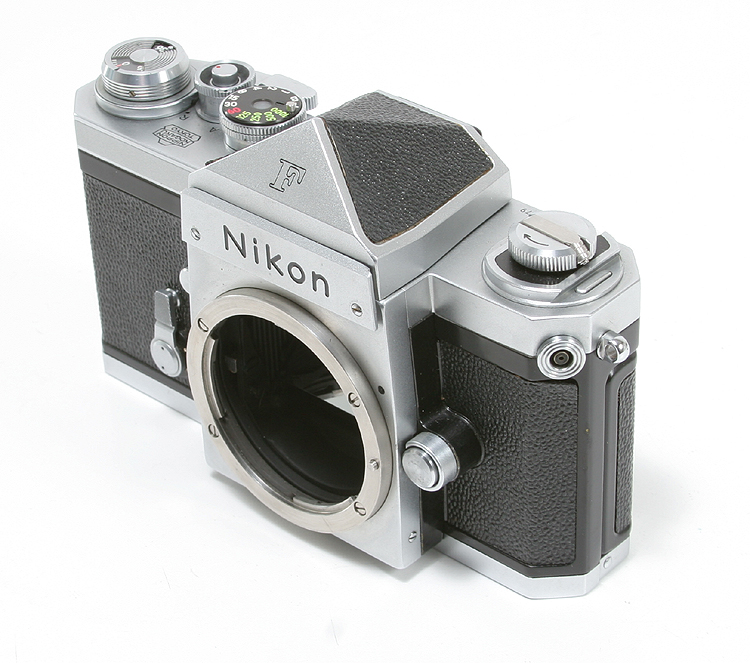
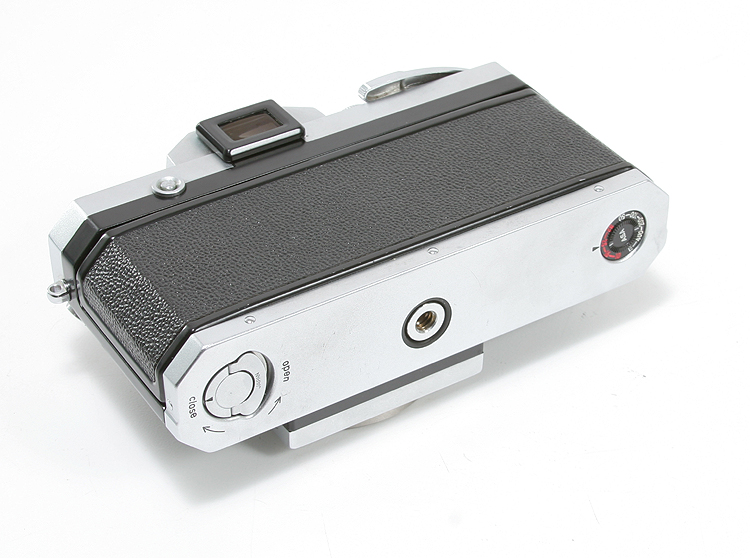
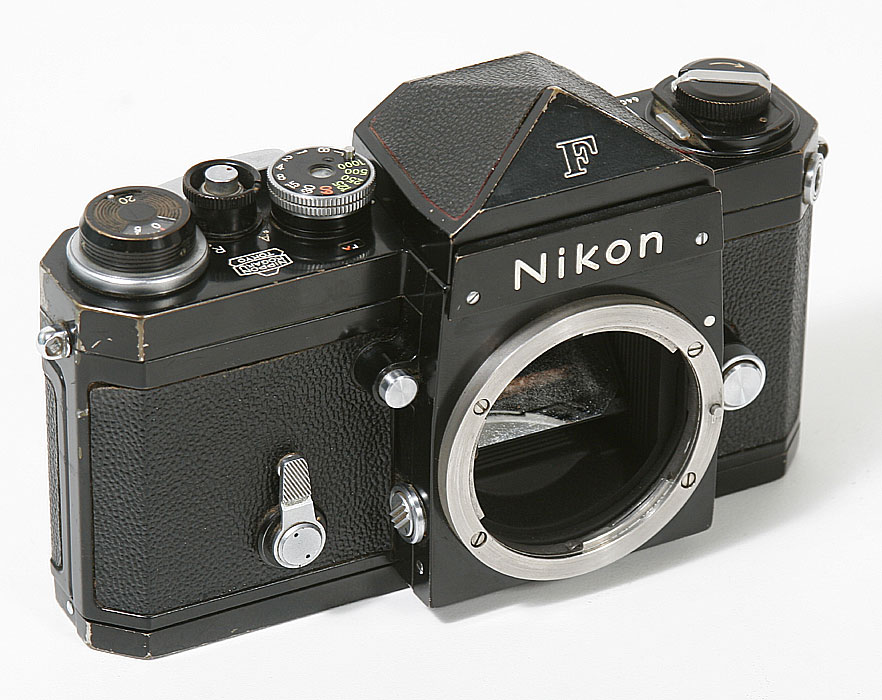
A similar vintage Nikon F body in black finish with black non-metred prism finder.
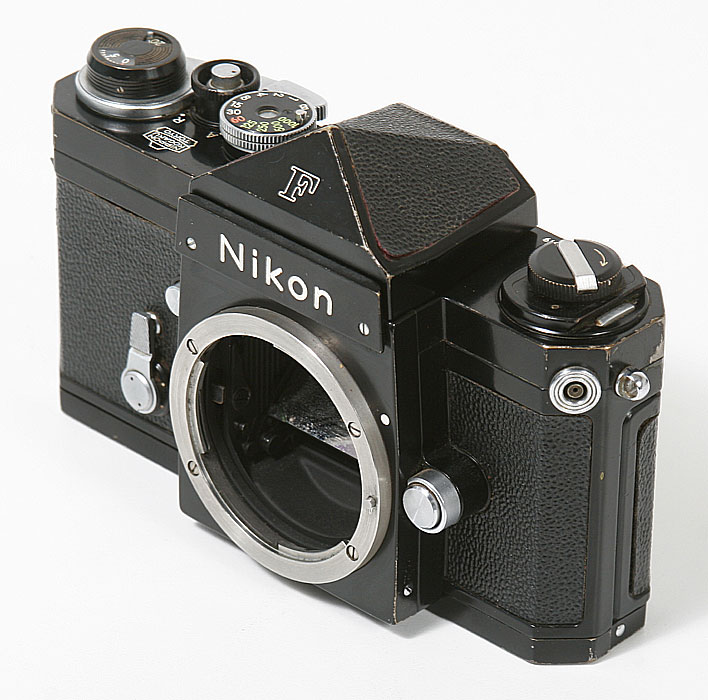
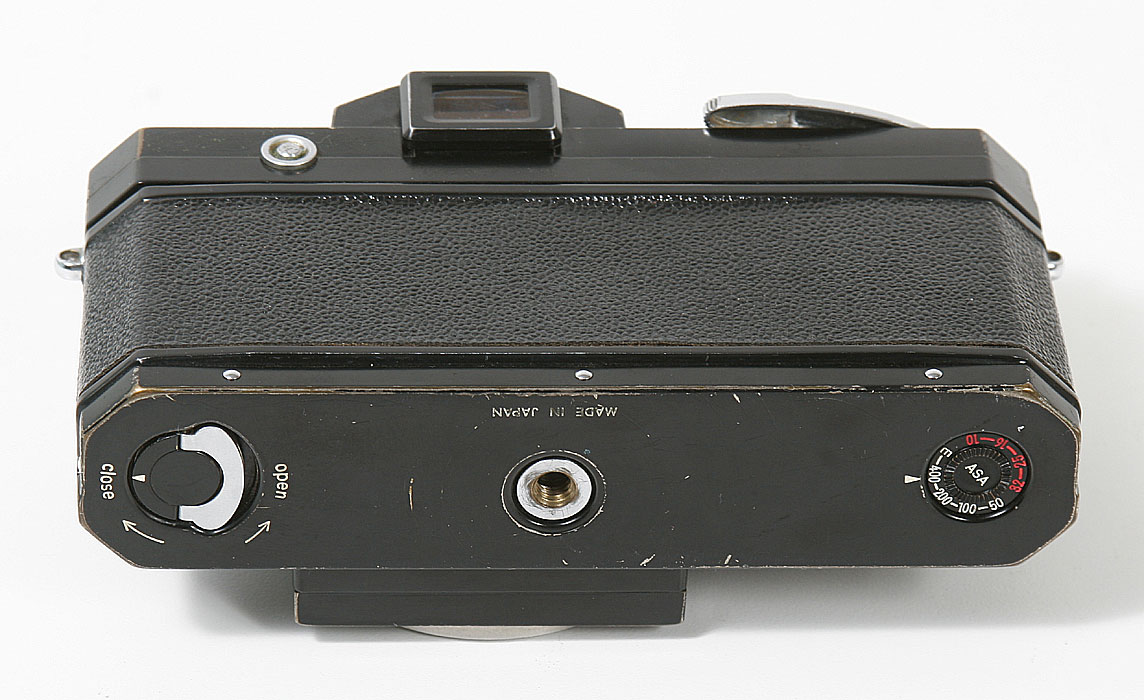
In spite of the fact that the Nikon F was a departure in camera design into unknown territory, and that
the camera was in production for about 15 years, the design changes made were mostly minor.

A fairly early chrome Nikon F body with non-metred prism finder and a NKK logo body cap.



A similar vintage Nikon F body in black finish with black non-metred prism finder.


Serial numbers on F cameras are in blocks. The first block was 64, with numbers starting at 6400001, running through 6499999. Subsequent blocks were 65, 66, 67, 68, 69, 70, 71, 72, 73, and 74. The 66 block was never finished. Not even close. A little over 2000 66s were produced, then the numbers were changed to 67. Also, the 74 block was not filled, as the camera was discontinued at serial number 7451052. Later numbers may be found, however, as Nikon supplied replacement top plates with serial numbers already engraved into the 746xxxx range.
It should be noted that the myth about the first two digits of the serial number indicating year of manufacture. It is partially true, and only by coincidence. The first cameras were sold in 1959, with a serial number block of 64xxxxx. At some point the serial number prefix did coincide with the year of manufacture. Production ended in 1974, in the 74 serial number block.
The first hundred or so cameras are different than the later batches in several ways. They were probably more of a pre-production run. The wide levers were solid, except for a hollow tip. The pins on the prism finder that the body locks on to are triangular.
Still among the first few thousand, the self timer lever changes from a cross hatch pattern on the early ones, to a set of vertically running ridges. The original finder was engraved under the front "Nippon Kogaku Japan". It became painted on, then changed again to "Nikon F Japan". The wind lever changed from completely hollow to solid.
The photomic meter prism was introduced in April, 1962. It would not fit on older cameras without cutting away part of the back of the prism well on the body. Cameras coming from the factory already modified were marked with a red dot engraved next to the serial number. I believe that all cameras where so marked once they started, although research shows red dot and non-red dot cameras intermixed in the 658xxxx and 659xxxx serial number range. I suspect this was due to camera not being assembled in strict serial number order rather than being produced both ways concurrently. To me, it
